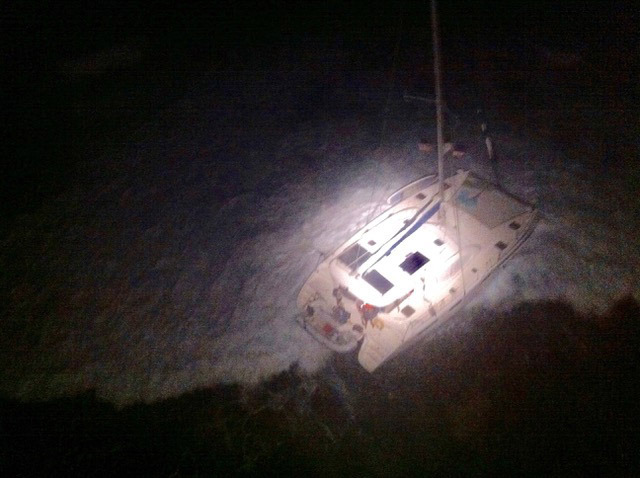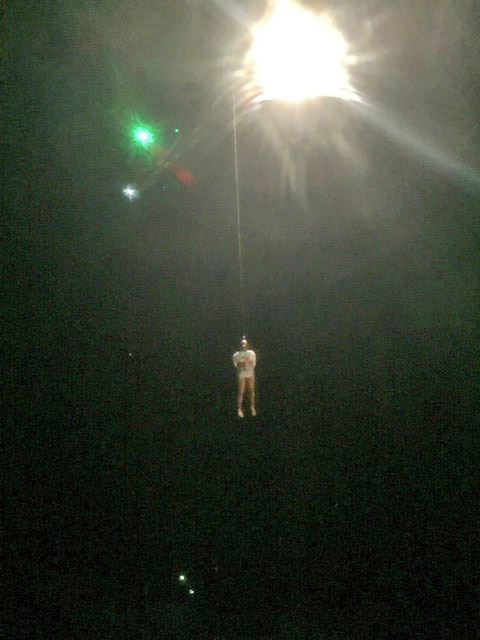
Accident Questions Accuracy of Navionics Charts

©2017Latitude 38 Media, LLC
The Ventura-based Leopard 46 catamaran Tanda Malaika went onto a reef while nearing Huahine in the Society Islands in the darkness of July 18. Skipper Danny Govatos had been monitoring the Navionics chart and the depthsounder when the latter suddenly went from showing a depth of 180 feet to 0 feet. The Navionics chart reportedly didn’t show a reef. There were six family members aboard the cat: Danny, his wife Belinda, and their children Jude, Mycah, Aidan and Emma.
"We all felt Tanda Malaika violently hit the reef," wrote Belinda in her blog. "Massive waves [reportedly eight to 10 feet] raised her port hull to about a 75- degree angle, then dropped her with an incredible force, back down onto the reef. I saw Mycah being thrown from port all the way to starboard, down the stairs of the starboard hull, and forward onto the floor in her cabin."
As it turned out, the entire family was rescued — in two trips — by a French Navy helicopter. There are numerous dramatic photos of the nighttime rescue on their website that convey just how chaotic and dangerous the situation was (you can also read the rest of Belinda’s gripping account of the events).
Miraculously, nobody was seriously hurt.

©2017Latitude 38 Media, LLC
When the family was safe on land again, two members of the French Navy asked what had happened. Belinda told them they’d hit a reef that didn’t appear on their chart. Belinda reports that the French asked if they had been using a Navionics chart.
"When I said ‘Yes’," wrote Belinda, "one man shook his head and said that at least five boats a year that were using Navionics charts end up on those reefs."
Belinda was taken to a large map on the wall and asked if a specific place was where the family’s cat had run aground. Belinda said that to the best of her knowledge, it was. She was then shown two places on the map, one being where Tanda Malaika went aground, and a second spot, between them, where most of the wrecks had occurred.
If you’ve cruised the South Pacific and used Navionics charts, we’d very much like your opinion of their accuracy. If they are inaccurate, even in just a few spots, mariners need to know about it.

©2017Latitude 38 Media, LLC
As for the Govatos family, they pretty much had all their worth in the boat, which they purchased two years ago in the Caribbean in order to travel the world and do humanitarian work. Unlike a lot of cruisers, they initially had insurance. But they report that when they got to the Galapagos, their insurance carrier dropped them, claiming they didn’t have enough experience. By that time they’d sailed 12,000 miles.
Back in the day, the owners of a shipwreck could simply walk away and that was that. In modern times, almost all countries demand that the owner pay to have the pollutants removed and the wreck taken away. It only took a couple of days for it to become clear that the Tanda Malaika was no longer a candidate for salvage, and needed to be towed out to deep water and sunk.
Alas, even that is going to cost money, as the salvage company charges $5,000 an hour. They won’t do anything until they get a $25,000 deposit, and estimate the entire job might cost $75,000.
Which raises the question, what will the French do if the Govatos family doesn’t have the money to pay for the removal? After all, they no longer have debtor’s prisons, and haven’t used the guillotine since 1976.
As the boat has been stable on the reef for the last nine days or so, many cruisers have come to help the family take everything of value off the boat. It’s a terribly sad scenario, as the sum of a boat is so much more than the parts.
If you’d like to help this family, this is their GoFundMe address: www.gofundme.com/helprescuethetribe.
